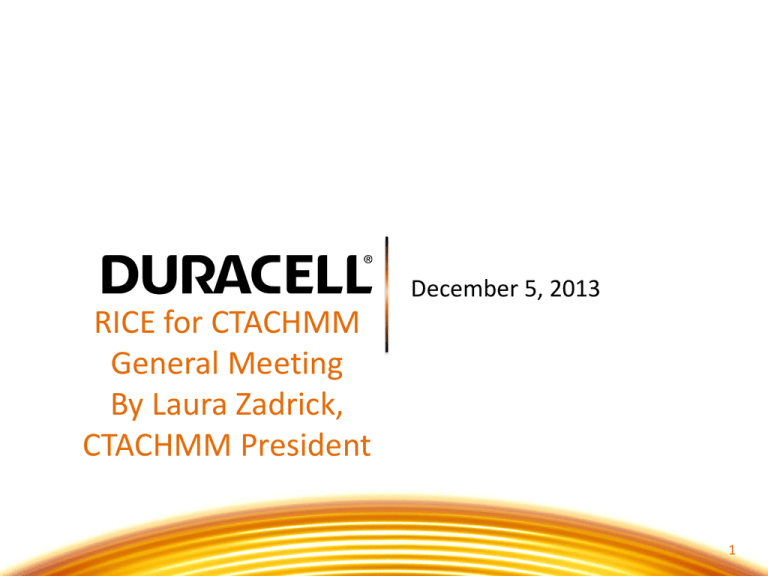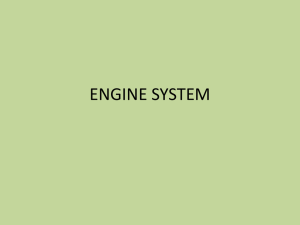Click Here for Presentation
advertisement

December 5, 2013 RICE for CTACHMM General Meeting By Laura Zadrick, CTACHMM President 1 RICE Regulations on Internal Combustion Engines 40CFR60.4200 RICE NESHAP – It’s Complicated • “40 CFR Part 63 Subpart ZZZZ . . . is the most complicated and confusing regulation in the entire suite of EPA NSPS and NESHAPS regulations, bar none. We seriously believe that a viable defense could be mounted against an EPA enforcement action with the simple but true statement, 'Your honor, we honestly could not discern our obligation under the rule in a timely manner.‘” • Public comment submitted in response to EPA’s request for public input on improving regulations per Executive Order 13563 • • • • • OVERVIEW What is a RICE Unit? Are your RICE Units subject to the RULE? Emergency vs. Non-Emergency Unit January 2013 Amendments What are your requirements? – – – – – – Notification Emission Limits Maintenance Operating Reporting Recordkeeping that you need to do What is a RICE Unit? • EPA defines a Stationary RICE unit as: • Reciprocating • Internal • Combustion • Engine – Reciprocating motion to convert heat energy into mechanical work – Non-road engine as defined in 40CFR 10683.30 – Not used to propel a motor vehicle • What RICE Units are Impacted? RICE applies to all existing, new & reconstructed non-road stationary reciprocating Internal Combustion Engines (CI & SI) • Except: – Emergency Engines • Existing or obligated to be available <15 hr/yr and not used for local reliability. • Engine must meet subpart ZZZZ emergency engine operational requirements – Mobile Units (non-road) • Next slide Stationary vs. Mobile • NOT COVERED UNDER RICE: Mobile (non-road): – Self-propelled (tractors), – Propelled while performing their function (lawnmowers), – Portable » Wheels, skids, carrying handles, trailer » Doesn’t stay in place for >12 months • Seasonal – full annual operating period Regulations differ according to: • New or Existing • Located at an Area or Major source • Engine is Compression or Spark Ignition – Spark is further subdivided • 2 vs. 4 stroke • Rich or Lean burn • • • REQUIREMENTS – NOTIFICATION Applicability – Non-emergency CI engines > 300 HP Installed before July 2006 (NESHAP) – Non-emergency SI engines > 500 HP Installed before July 2007 (NESHAP); – Non-emergency CI engines manufactured after July 2006 (NSPS) – Non-emergency SI manufactured after July 2007 (NSPS) Submit Letter to EPA Region with: – Facility Name – Engine Make/Model/Serial# & Engine Family – Testing Requirements – Max Engine Power/Displacement/Fuel – Controls, if in place – Fuel Used – Emission Limits Submission Date – NSPS – due with 30 days after construction – NESHAP – February 11, 2012 unless Tier I or II engines using BMP due March 2013 RICE REQUIREMENTS – EMISSION LIMITS • RICE NESHAP (CI/SI Installed before July 2006/2007) – – < 300 HP –none > 300 HP – Must meet CO Emission limit • Must Submit Initial Compliance Notice by May 3, 2013 (CI), October 19, 2013 (SI) – If compliant, maintain records and retest if engine reconstructed – If Non-Compliant, install controls to achieve limits or reduce emissions by 70% – > 500 HP – Must meet CO and/or formaldehyde (Major) emission limits • Must conduct Initial stack test by May 3, 2013 (CI ) and October 19, 2013 (SI) – If compliant, maintain records and retest every 3 yrs. or 8760 hours of operation – If Non-Compliant, install controls to reduce emissions by 70% and retest every 3 yrs. or 8760 hours of operation • RICE NSPS (CI/SI manufactured after July 2006/2007) – Obtain Engine Manufacturer Emissions Certificate and demonstrate compliance with NOx, CO, PM, VOC, NMHC • If demonstrates compliance, maintain certificate • If certificate is not available or certificate indicates exceedances: – Conduct Stack Test within 60 days of installation to determine emissions, install controls if required and re-test to demonstrate compliance (must meet emission limit) Year of Manufacture RICE MACT (HAPS) < June 2006 (NOx, CO, PM, NMH) > June 2006 Yes Emergency Logs (Install Hour Meter) No Maintenance < 300 BHP-hr (CI) < 500 BHP –hr (SI) >300 BHP-hr (CI) > 500 BHP –hr (SI) Logs Notification Maintenance RICE NSPS Emission Certification Available No Yes Notification Notification (Submit within 90 days of startup) (Submit within 90 days of startup) Testing Emissions Testing (Submit CI – Nov 1, 2013 Submit SI – April 16, 2014) Logs Reporting • Compliant; or • Install Controls; or • Decommission Emergency vs. Non-Emergency RICE Emergency Reciprocating Stationary Internal Combustion Engine • Any stationary internal combustion engine whose operation is limited to emergency situations and required testing and maintenance. – Examples: • Generators – produce power for critical operations when power from local utility is interrupted • Fire Pumps – pump water in case of fire • Stationary CI ICE used to supply power to an electric grid or that supply power as part of a financial arrangement with another entity are not considered to be emergency engines. – (Otherwise known as Load Shed Program) – Changes in 2013 Amendments Emergency RICE Requirements Engine Manufacturer Requirements • Generators – Required to certify 2007 model year and later non-fire pump engines with displacement <30 liters/cylinder. • Fire pump engines – Required to certify beginning 2008 – 2011 (3 years later if rated speed is greater than 2650 rpm) according to Table 3 of Subpart IIII. • Engines with displacement > 30 liters/cylinder are not required to be certified by the manufacturer. • Owners or operators of engines which are not certified by the manufacturer must demonstrate compliance Hours of Operation Limit • Operated up to 100 hours/year for M,I &T, provided the test are recommended by the Federal/State/local government, the manufacturer, the vendor, or the insurance company. • There is no time limit on the use in emergency situations. • Operate up to 50 hours per year in non-emergency situations – but those 50 hours are counted towards the 100 hours per year provided for MIT. – The 50 hours per year for non-emergency situations cannot be used for peak shaving or to generate income for a facility to supply power to an electric grid or otherwise supply non-emergency power as part of a financial arrangement of another entity – For owners and operators of emergency engines, any operation other than emergency operation, maintenance and testing, and operation in non-emergency situations for 50 hours per year, as permitted in this section is prohibited. Emergency ICE Hours of Operation Limit • Bottom line- now you have to track & manage your engine use to avoid exceeding usage limits under the definition of emergency • If you run your engine in excess of allowable non-emergency hours/year – you have to comply with RICE NESHAP requirements for non-emergency engines Monitoring Requirements • Install - Non-resettable hour meter prior to startup of the engine. • If you are required to have a diesel particulate filter, the filter must be installed with a backpressure monitor that notifies the operator when the high backpressure limit of the engine is approached. Fuel Requirements • Diesel Fuel – Max 500 ppm sulfur – Min cetane index of 40 or Max aromatic content of 35 volume % • 10/1/2010 – Emergency Generators <30 litres/cylinder – Sulfur content: Max 15 ppm • 6/1/2012 – Emergency Generators >30 litres/cylinder – Sulfur content: Max 1,000 ppm Operate & Maintain • Annually or every 500 hours – Change Oil & Oil Filter – Inspect Belts • Annually or every 1,000 hours – CI – Inspect air cleaner – SI – Inspect spark plugs • Any additional requirements according to manufacturer’s written instructions. RULE SUMMARY NESHAP FOR RICE AREA SOURCES Emergency Engines • Install Hour Meter • Operate less than: 100 hours for T/M 50 hours for Non-emergency • Complete required maintenance 1. 2. Engines w/ Fuel Input <300 HP (CI) <500 HP (SI) • Maintenance Change Oil Inspect air filter, hoses, belts Operate/Maintain in accordance with manufacturer’s recommendations 1 Engines w/ Fuel Input > 300 HP (CI)2 500 HP (SI) • Notify • Emission Limits Initial stack test 70% reduction if does not meet limits • Maintenance Required • Semi-Annual Deviation Reports RICE NSPS CI Installed after July 2006 of SI installed after July 2007 • Notify • Emission Limits Manufacturer Emissions Certificate Stack Test (if not certified) to demonstrate compliance and/or required controls CI – Engines manufactured or installed before July 2006. SI Engines manufactured and installed before July 2007. If Engines exceed 500 HP of heat input, they must conduct stack testing every 3 years or 8760 hours of operation Regulations • National Emission Standard for Hazardous Air Pollutants (NESHAP) for Reciprocating Internal Combustion Engines (RICE) – 40 Code of Federal Regulations Part 63, Subpart ZZZZ ("the RICE rule") • New Source Performance Standards (NSPS) - Standards of Performance for Stationary Spark Ignition Internal Combustion Engines (40 CFR Part 60 Subpart JJJJ - Scroll to reach the Subpart.) – "the Spark Ignition NSPS rule" • Standards of Performance for Stationary Compression Ignition Internal Combustion Engines (40 CFR Part 60 Subpart IIII - Scroll to reach the Subpart.) – "the Compression Ignition NSPS rule" Jan. 30, 2013 Amendments After the promulgation of the 2010 amendments, EPA received several petitions. Amendments effective April 1, 2013 Minor amendments/clarifications also made to NSPS Jan 30, 2013 Amendments – Major Issues addressed: • Emergency engine operation for demand response & peak shaving • Requirements for existing 4-stroke SI RICE at area sources of HAP • Total hydrocarbon (THC) compliance option for 4-stroke rich burn SI RICE • Tier1/Tier 2 Certified CI RICE scheduled for replacement • Tier 3 Certified CI RICE • CI RICE at area sources of HAP in remote areas of Alaska* • CI RICE on offshore vessels* * Not covered in this presentation Emergency Engine Operational Limitations • Emergency engine operation limited to: – Unlimited use for emergencies (fire/power outage) – 100 hr/yr for MIT & Emergency demand response – 50 hr/yr of the 100 hr/yr allocation can be used for: • Non-emergency situation, no financial arrangement • Local reliability as part of a financial arrangement with another entity if specific criteria met (existing RICE at area sources of HAP only) • Peak shaving until May 3, 2014 (existing RICE at area source of HAP only) • Note: EPA did not finalize the proposed 50 hr provision for peak shaving until April 2017 Emergency Engine Operational Limitations • Operation for emergency demand response allowed if: – Energy Emergency Alert Level 2 has been declared by Reliability Coordinator – Voltage or frequency deviate by 5% or more below standard • Operation for local reliability allowed if: – Engine is dispatched by local transmission/distribution system operator – Dispatch intended to mitigate local transmission limitations so as to avert potential voltage collapse or line overloads – Dispatch follow reliability, emergency operation, that follow specific NERC, state/local standards or guidelines – Power provided only to facility or to support local distro system – Owner/operator identifies & records dispatch and standard that is being followed Fuel Requirements for Emergency Engines • Requirements apply to emergency CI RICE >100 HP and displacement <30 liters/cylinder • Operated or contractually obligated to be available >15 hr/yr (up to 100 hr/yr) for emergency demand response or voltage/frequency • Operated for local reliability (up to 50 hr/yr) • Beginning 1/1/2015 – use ultra low sulfur diesel fuel – Existing inventory may be depleted Reporting Requirements for EE • RICE>100 HP – >15hr/yr – Operated local reliability up to 50 hr/yr • Beginning with 2015 operation – report March, 2016 – – – – Facility name/address Engine rating, model year, lat/long Date, start time, end time for operation Number of hrs engine is contractually obligated for emergency demand response – Entity that dispatched engine for local reliability – Deviations from fuel requirement • Submit report electronically through the Compliance & Emissions Data Reporting Interface SI 4-Stroke RICE>500 HP at Area Sources • Original 2010 RICE NESHAP required existing 4-stroke SI RICE >500 HP at area sources of HAP to meet emission limits for CO or Formaldehyde • 2013 Amendments removed the emission limits & estabilshed the following: – Engine in remote area must meet management practices – Engines not in remote area must meet equipment standard & other requirements Remote Definition • Located in offshore area • Located on a pipeline segment with 10 or fewer building intended for human occupancy & no building with 4 or more stories within 220 yards on either side of a continuous 1 mile length of pipeline (DOT Class 1 area), and the pipeline segment is not within 100 yards of a building or small welldefined outside area • Not located on a pipeline and having 5 or fewer buildings intended for human occupancy and no buildings with 4 or more stories within a 0.25 mile radius around the engine • Engine must meet remote definition as of 10/19/2013 Remote Area Source SI RICE Requirements • Existing non-emergency 4-stroke lean burn & rick burn SI RICE >500 HP at area sources of HAP that are in remote areas: – Change oil & filter every 2160 hrs of operation or annually – Inspect spark plugs, hoses, & belts every 2160 hrs of operation or annually & replace as necessary • Keep records of maintenance • Evaluate remote status annually & keep records • If no longer remote, comply with non-remote engine requirements within 1 year Non-Remote Area Source SI RICE Requirements • Existing non-emergency 4-storke SI RICE>500 HP at area sources of HAP that are not in remote areas: – Equipment standard requiring catalyst on engine – 4-stroke lean burn RICE: install oxidation catalyst; 93% CO reduction or 47 ppmvd CO – 4-stroke rich RICE: install non-selective catalytic reduction; 75% CO reduction, 30% THC reduction or 270 ppmvd CO – Initial & annual catalyst activity checks • Initial 3 15-min. runs • Annual; 1 15-min run – High catalyst inlet temp engine shutdown, or continuous catalyst inlet temp monitoring – Notifications & compliance reporting If using subpart ZZZZ Appendix A, run must be at least one measurement cycle & include at least 2 mins of test data phase measurement THC Compliance Option • 2004 RICE NESHAP established for formaldehyde limit for nonemergency 4SRB SI RICE >500 HP at major sources – Either reduce formaldehyde by 76% or limit to 350ppbvd • Amendment specifies that engines meeting the 76% formaldehyde reduction standard can show compliance by demonstrating through testing that THC is reduced by at least 30% Tier1/Tier 2 Certified Engines Scheduled for Replacement 2010 rule required existing non-emergency CI RICE >300 HP to comply with CO limit ►Engines would likely not comply without catalyst retrofit ►California state/local rules require CI engines certified to Tier 1 or Tier 2 standards to be replaced in next few years ►Tier 1 = model years 1996 – 2001/2002 ► Tier 2 = model years 2001/2002 – 2005 ► Amendment specifies that existing non-emergency CI RICE >300 HP at area sources certified to Tier 1 or 2 and subject to enforceable state/local rule that requires replacement can comply with management practices until January 1, 2015, or 12 years after the installation date of the engine, but not later than June 1, 2018 ►Must submit notification by March 3, 2013, identifying state/local regulation 26 Tier 3 Certified Engines • Tier 3* (model year 2006) CI RICE that were constructed (installed) between January 1-June 12, 2006 are existing engines under NESHAP • ►Under 2010 rule, subject to CO emission limit that would likely require catalyst retrofit • ►Identical Tier 3* engine installed after June 12, 2006, does not require retrofit to comply with applicable EPA rule for that engine (NSPS) • ►Amendment specifies that existing non-emergency CI RICE >300 HP at area sources certified to Tier 3* standards can comply with RICE NESHAP by complying with the CI ICE NSPS (subpart IIII) *Tier 2 for engines >560 kW Tables for Clarification Emission Standard: Existing RICE Located at Major Sources Emission Standards – New RICE








